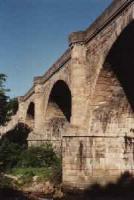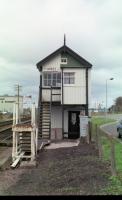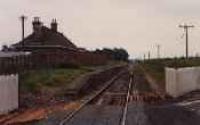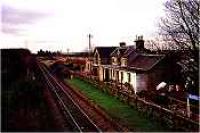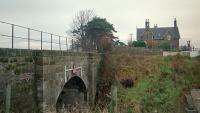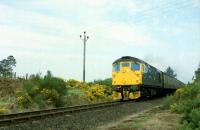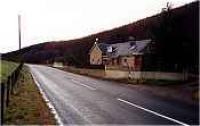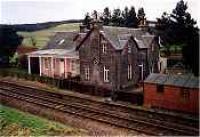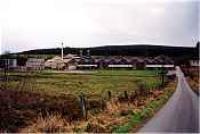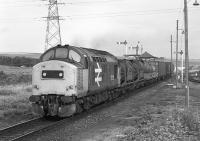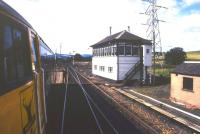Inverness and Aberdeen Junction Railway
Introduction
This railway was promoted to complete the line between Inverness and Aberdeen by closing the gap between the Inverness and Nairn Railway and the Great North of Scotland Railway (which by focussing too much on its branches failed to complete the line west from Aberdeen to Inverness. This line is open. Passenger services are provided by ScotRail from Inverness to Aberdeen, Glasgow and Edinburgh. Stations remain at Keith, Elgin, Forres and Nairn.
Why built
This line completed the route between Aberdeen and Inverness by connecting the Great North of Scotland Railway at Keith to the Inverness and Nairn Railway at Nairn.
Dates
Route described
The line was, and is, single track. Provision was made between Nairn and Alves for a double track which was never laid. The Nairn Viaduct (see entry) was built to allow a second track but the main line remained single track although a siding did come to use the available trackbed.
Locations along the line
These locations are along the line.
This is a two platform station in the south of Nairn. The station buildings on both platforms are similar to those at Pitlochry. The main building, a single storey, is on the eastbound (Aberdeen) platform, on the town side of the station. Thought to be designed by William Roberts and Murdoch Paterson it dates from 1885 and is 'B' listed. The platforms are linked by a lattice ...
More detailsSee also
Inverness and Nairn Railway
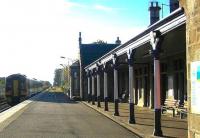
John Furnevel 02/11/2005
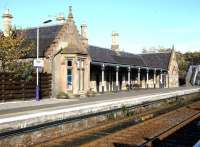
John Furnevel 02/11/2005
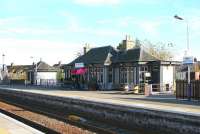
John Furnevel 02/11/2005
This is a double track stone arch viaduct, just east of Nairn station designed by Joseph Mitchell. It carries a single track.
...
This was a single platform station which became a two platform station with the addition of a passing loop. The original platform was to the south of the line.
...
Brodie station had a passing loop and two platforms. The main station building, which still stands as a house, was on the westbound platform. Also known as Brodie Castle Station for the nearby castle, this name being displayed around the station clock.
...

Ewan Crawford //1998
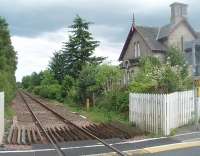
Mark Bartlett 28/06/2011
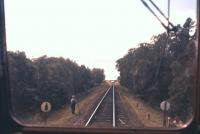
Frank Spaven Collection (Courtesy David Spaven) //1962
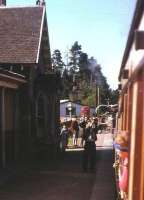
Frank Spaven Collection (Courtesy David Spaven) /08/1965
This was a short lived terminus west of Forres on the Inverness and Aberdeen Junction Railway, opened with its line from Nairn to Dalvey. Arguably Dalvey [1st] was the first station in, or rather for, Forres. It was located outside the town to the west of the Findhorn Viaduct [Forres], the completion of which led to the closing of the temporary terminus as the line was extended ...
More detailsThis is a wrought iron single track box girder viaduct over the River Findhorn a little west of Forres station. Trains pass through the box girders. The viaduct is 609 ft long overall with three girder sections, two piers being on the riverbed. The engineer was Joseph Mitchell.
...
This junction was the western apex of the triangular junction created with the opening of the Inverness and Perth Junction Railway and its Forres [2nd] station in 1863. The line met the existing 1858 Inverness and Aberdeen Junction Railway.
...
See also
Inverness and Perth Junction Railway

Crinan Dunbar 19/11/2017
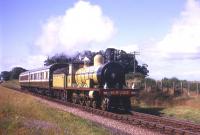
Frank Spaven Collection (Courtesy David Spaven) /09/1965
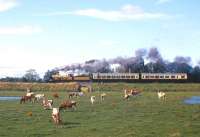
Frank Spaven Collection (Courtesy David Spaven) /09/1965

Douglas Blades 29/08/2017
This is a modern two platform station, a footbridge with lifts, a station building on the westbound platform and a car park to the south. It is the third Forres station (fourth if we include a temporary station, Dalvey [1st]). Opening was in late 2017, the new station being to the north of Forres [2nd]. The station is on a long loop.
...
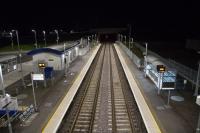
Ewan Crawford 05/10/2018
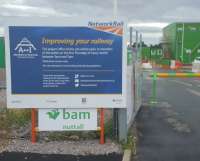
John Yellowlees 01/09/2016

Alan Cormack 07/07/2017

Alan Cormack 07/07/2017
This was a two platform station on the Inverness to Aberdeen line. The station building, typical of the line, was on the down platform which was the town side of the station. It opened with the extension of the Inverness and Aberdeen Junction Railway from Dalvey [1st] to Elgin.
...
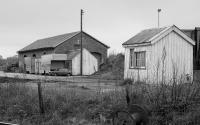
Bill Roberton //1991
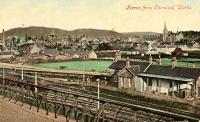
Ewan Crawford Collection //
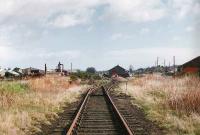
Brian Forbes //1993
This junction was the eastern apex of the triangular junction created with the opening of the Inverness and Perth Junction Railway and its Forres [2nd] station in 1863. The line met the existing 1858 Inverness and Aberdeen Junction Railway.
...
See also
Inverness and Perth Junction Railway
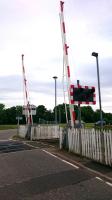
Alan Cormack 21/06/2017
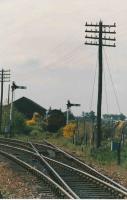
Crinan Dunbar //1988

John Furnevel 03/11/2005
The last station at Kinloss opened in 1904 on the site of the original station, replaced Kinloss [2nd] which was to the east. It was a two platform station with a long passing loop (around twice the length of the platforms), which started west of a level crossing to the west of the station. The main station building was on the eastbound platform with a waiting room opposite. In addition to ...
More details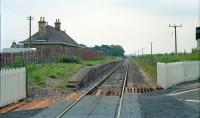
Ewan Crawford //1990
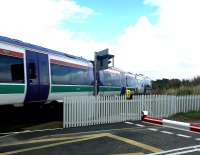
John Furnevel 12/09/2004
Kinloss station was relocated to the east almost as soon as it opened with the opening of the short lived Findhorn Railway. The new station had one platform face on each line, there was an island platform in the 'V' of the junction. There was a loop on the branch line.
...
See also
Findhorn Railway

Frank Spaven Collection (Courtesy David Spaven) //
This is the junction for the Hopeman Branch (Inverness and Aberdeen Junction Railway). Both the branch and main line are single track. The branch joins so that trains from the east may run straight onto the branch. The junction is not far west of the former Alves station.
...
See also
Burghead Branch (Inverness and Aberdeen Junction Railway)
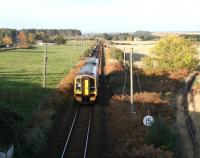
John Furnevel 02/11/2005

Peter Todd 03/08/1979

Peter Todd 03/08/1979

Peter Todd 03/08/1979
This was a two platform station to the east of Alves Junction. The main station building, now a house, was on the eastbound platform. The east of the station is crossed by a road bridge.
...
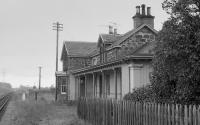
Bill Roberton //1977
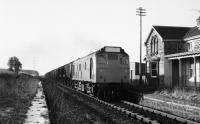
Peter Todd 05/02/1979
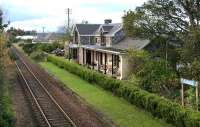
John Furnevel 02/11/2005
In 1898 a signal box was provided for the short mineral line to Newton Quarries (also known as Mosstowie) a quarry which was west of the former Mosstowie station. It was locomotive worked between 1898 and ~1937.
...
This was a minor station with a long loop. The platforms were considerably shorter than the loop and close to its eastern end where a road bridge crossed the line. The main station building was on the westbound platform with a small waiting room opposite. The platforms were staggered, the eastbound platform being slightly to the west.
...
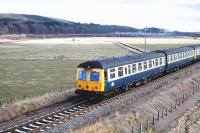
Peter Todd 02/04/1979
This is a two platform station with the modern station building on the eastbound platform and a car park on the north side. A third platform, a bay, is planned for the west end of the station for services terminating from Inverness.
...
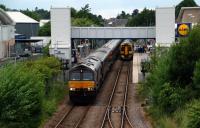
John Clark 20/06/2023
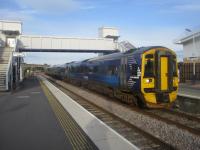
David Bosher 14/06/2019

David Bosher 14/06/2019
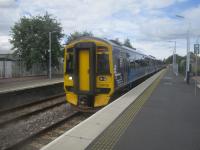
David Bosher 16/06/2019
A junction opened in 1858 between the 1852 Morayshire Railway and the 1858 Inverness and Aberdeen Junction Railway.
...
See also
Morayshire Railway
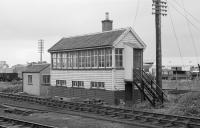
Bill Roberton //1977
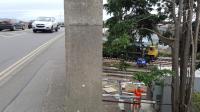
Crinan Dunbar 14/10/2017

...
Bill Roberton //1991

Crinan Dunbar 11/10/2017
This was a one platform station just south of the town of Lhanbryde. The platform was on the north side of the line. The station building, typical of the line, remains standing in use as a house.
...
This was a three platform station. The main station building, of two storeys, was on the eastbound platform and this remains as a house. The building is roughly 'H' shaped in plan with a covered porch alongside the platform. When first opened it was the station for Fochabers (some 3 and a half miles away across the River Spey) and became the junction for the short branch for the town in 1893.
...
See also
Fochabers Branch (Highland Railway)

Peter Todd 19/10/1980
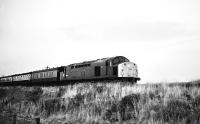
Peter Todd 18/01/1979

Peter Todd 15/10/1980
This was a two platform station with a passing loop. The main station building, of two storeys, was on the southbound/eastbound platform. There was a goods yard at the north end, approached from the south.
...
This was the junction between the Inverness and Aberdeen Junction Railway and the extension of the Morayshire Railway south to Craigellachie [1st]. Both lines were single track and opened in 1858. The junction was south of Orton station and west of the [Boat o' Brig Viaduct] on the main line east to Aberdeen.
...
See also
Morayshire Railway

Caleb Abbott 02/10/2018

Peter Todd 30/03/1979
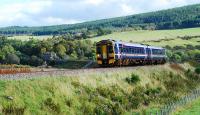
Ewan Crawford 30/09/2009
This single track viaduct crosses the River Spey to the east of Orton. Also known as Spey Bridge, one of many, or Orton Bridge.
...

John Clark 30/08/1993

John Clark /07/1975

John Gray 01/05/2014
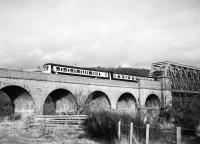
Peter Todd 02/03/1979
This was a station with a passing loop, two platforms and a signal box at either end. The main station building was on the westbound platform.
...
This was a single platform halt built for the Glentauchers Distillery, to the south of the line. Opened 1922 and public from 1955.
...
This signal box was west of the Highland Railway part of Keith station. It controlled the approach to the station and goods yard, to the east, and the junction between the Inverness and Aberdeen Junction Railway, of 1856, and the Buckie and Portessie Branch (Highland Railway), of 1884.
...
See also
Buckie and Portessie Branch (Highland Railway)
This shed was on the north side of the west end of Keith station. It was the shed of the Inverness and Aberdeen Junction Railway (later Highland Railway) opening here because this was the east end of the line from Inverness where trains were handed over to the Great North of Scotland Railway to continue their journey south east to Aberdeen. The shed was approached from the ...
More detailsThis is a one platform station, with a second out of use platform on the former route to Dufftown. There is a passing loop to the east of the station, inconvenient when trains are running late.
...
See also
Buckie and Portessie Branch (Highland Railway)
Great North of Scotland Railway
Keith and Dufftown Railway
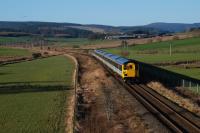
John Clark 26/02/2023
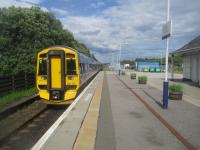
David Bosher 16/06/2019
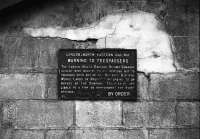
...
Peter Todd 19/01/1979

...
Peter Todd 19/01/1979
This refers to the actual junction. For the station see Keith. This junction was formed in 1858 between the Great North of Scotland Railway and the Inverness and Aberdeen Junction Railway further added to with the opening of the Keith and Dufftown Railway in 1862.
...
See also
Great North of Scotland Railway
Keith and Dufftown Railway
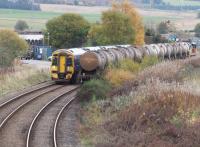
Duncan Ross 28/10/2020
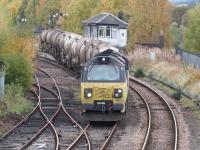
Duncan Ross 28/10/2020
Books











